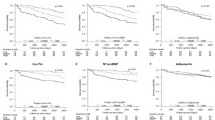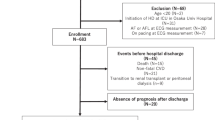Abstract
QT-interval parameters are potential indicators of increased cardiovascular risk. We evaluated prospectively their prognostic value, in relation to other risk markers, for cardiovascular fatal and nonfatal events in a cohort of 271 hypertensive type 2 diabetic outpatients. QT intervals were measured from 12-lead standard ECGs obtained on admission and maximum rate-corrected QT-interval duration and QT-interval dispersion (QTd) calculated. Clinical and laboratory data and 2-D echocardiograms (available in 126 patients) were recorded. Survival analyses included Kaplan–Meier survival curves, uni and multivariate Cox proportional-hazards models. After a median follow-up of 55 months (range 2–84), 68 total fatal or nonfatal cardiovascular events and 34 cardiovascular deaths (24 of them from cardiac causes) were observed. In multivariate Cox analysis, QTd was an independent predictor for total cardiovascular events (HR: 1.16, 95% CI: 1.01–1.34, for each 10 ms increments) and for cardiac deaths (HR: 1.28, 95% CI: 1.01–1.60). Other independent risk indicators for cardiovascular morbidity and mortality were echocardiographic left ventricular hypertrophy (Echo-LVH), serum triglycerides, presence of pre-existing cardiac and peripheral arterial disease, age, diabetes duration, heart rate and the presence of frequent ventricular premature contractions on ECG. The combination of QTd and Echo-LVH improved cardiovascular risk stratification compared with either alone, the presence of both prolonged QTd (>65 ms) and Echo-LVH was associated with a 3.2-fold (95% CI: 1.7–6.1) increased risk of a first cardiovascular event and a 5.9-fold (95% CI: 2.1–16.4) increased risk of cardiovascular death. Thus, QT provided additive prognostic information for cardiovascular morbidity and mortality beyond that obtained from conventional risk markers, including Echo-LVH, in type 2 diabetic patients with arterial hypertension.
This is a preview of subscription content, access via your institution
Access options
Subscribe to this journal
Receive 12 digital issues and online access to articles
$119.00 per year
only $9.92 per issue
Buy this article
- Purchase on Springer Link
- Instant access to full article PDF
Prices may be subject to local taxes which are calculated during checkout


Similar content being viewed by others
References
Somberg JC, Molnar J . Usefulness of QT dispersion as an electrocardiographically derived index. Am J Cardiol 2002; 89: 291–294.
Zabel M, Klingenheben T, Franz MR, Hohnloser SH . Assessment of QT dispersion for prediction of mortality or arrhythmic events after myocardial infarction. Results of a prospective, long-term, follow-up study. Circulation 1998; 97: 2543–2550.
Brendorp B et al. QT dispersion has no prognostic information for patients with advanced congestive heart failure and reduced left ventricular systolic function. Circulation 2001; 103: 831–835.
Salles G et al. Prognostic value of QT interval parameters for mortality risk stratification in Chagas'disease: results of a long-term follow-up study. Circulation 2003; 108: 305–312.
Cardoso C, Salles G, Deccache W . Prognostic value of QT interval parameters in type 2 diabetes mellitus: results of a long-term follow-up prospective study. J Diab Comp 2003; 17: 169–178.
de Bruyne MC et al. Prolonged QT interval predicts cardiac and all-cause mortality in the elderly. The Rotterdam Study. Eur Heart J 1999; 20: 278–284.
Malik M, Batchvarov VN . Measurement, interpretation and clinical potential of QT dispersion. J Am Coll Cardiol 2000; 36: 1749–1766.
Mayet J et al. Left ventricular hypertrophy and QT dispersion in hypertension. Hypertension 1996; 28: 791–796.
Oikarinen L et al. Relation of QT interval and QT dispersion to echocardiographic left ventricular hypertrophy and geometric pattern in hypertensive patients. The LIFE study. J Hypertens 2001; 19: 1883–1891.
Galinier M et al. Prognostic value of ventricular arrhythmias in systemic hypertension. J Hypertens 1997; 15: 1779–1783.
Saadeh AM, Jones JV . Predictors of sudden cardiac death in never previously treated patients with essential hypertension: long-term follow-up. J Hum Hypertens 2001; 15: 677–680.
Oikarinen L et al. QRS duration and QT interval predict mortality in hypertensive patients with left ventricular hypertrophy. The losartan intervention for end point reduction in hypertension study. Hypertension 2004; 43: 1029–1034.
Cardoso CRL, Salles GF, Deccache W . QTc interval prolongation is a predictor of future strokes in patients with type 2 diabetes mellitus. Stroke 2003; 34: 2187–2194.
Salles GF, Bloch KV, Cardoso CRL . Mortality and predictors of mortality in a cohort of Brazilian type 2 diabetes mellitus patients. Diab Care 2004; 27: 1299–1305.
Schillaci G et al. Continuous relation between left ventricular mass and cardiovascular risk in essential hypertension. Hypertension 2000; 35: 580–586.
Cardoso C et al. Clinical determinants of increased QT dispersion in patients with diabetes mellitus. Int J Cardiol 2001; 79: 253–262.
Salles GF, Cardoso CRL, Deccache W . Multivariate associates of QT interval parameters in diabetic patients with arterial hypertension: importance of left ventricular mass and geometric patterns. J Hum Hypertens 2003; 17: 561–567.
Day CP, McComb JM, Campbell RWF . QT dispersion: an indication of arrhythmia risk in patients with long QT intervals. Br Heart J 1990; 63: 342–344.
Devereux RB, Reichek N . Echocardiographic determination of left ventricular mass in man. Anatomic validation of the method. Circulation 1977; 55: 613–618.
Levy D et al. Echocardiographic criteria for left ventricular hypertrophy: The Framingham Heart Study. Am J Cardiol 1987; 59: 956–960.
Greenland S, Finkle WD . A critical look at methods for handling missing covariates in epidemiologic regression analysis. Am J Epidemiol 1995; 142: 1255–1264.
Concato J, Feinstein AR, Holford TR . The risk of determining risk in multivariate models. Ann Intern Med 1993; 118: 201–210.
Kors JA, van Herpen G, van Bemmel JH . QT dispersion as an attribute of T-loop morphology. Circulation 1999; 99: 1458–1463.
Lee KW, Kligfield P, Dower GE, Okin . QT dispersion, T wave projection, and heterogeneity of repolarization in patients with coronary artery disease. Am J Cardiol 2001; 87: 148–151.
Rana BS et al. Relation of QT-interval dispersion to the number of different cardiac abnormalities in diabetes mellitus. Am J Cardiol 2002; 90: 483–487.
Messerli FH, Grodzicki T . Hypertension, left ventricular hypertrophy, ventricular arrhythmias and sudden death. Eur Heart J 1992; 13(suppl D): 66–69.
Curb JD et al. Sudden death, impaired glucose tolerance and diabetes in Japanese American men. Circulation 1995; 91: 2591–2595.
Okin PM et al. Combined echocardiographic left ventricular hypertrophy and electrocardiographic ST depression improve prediction of mortality in American Indians. The Strong Heart Study. Hypertension 2004; 43: 769–774.
Gueyffier F et al. Identification of risk factors in hypertensive patients. Contribution of randomized controlled trials through an individual patient database. Circulation 1999; 100: e88–e94.
Florkowski CM, Scott RS, Coope PA, Moir CL . Predictors of mortality from type 2 diabetes mellitus in Canterbury, New Zealand; a ten-year cohort study. Diab Res Clin Prac 2001; 53: 113–120.
Palatini P, Casiglia E, Julius S, Pessina AC . High heart rate: a risk factor for cardiovascular death in elderly men. Arch Intern Med 1999; 159: 585–592.
Verdecchia P et al. Left ventricular mass and cardiovascular morbidity in essential hypertension: the MAVI Study. J Am Coll Cardiol 2001; 38: 1829–1835.
Harrell FE, Lee KL, Mark DB . Multivariable prognostic models: issues in developing models, evaluating assumptions and adequacy, and measuring and reducing errors. Stat Med 1996; 15: 361–387.
Clement DL et al. Prognostic value of ambulatory blood-pressure recordings in patients with treated hypertension. N Engl J Med 2003; 348: 2407–2415.
Kors JA et al. T axis as an indicator of risk of cardiac events in elderly people. Lancet 1998; 352: 601–605.
Zabel M et al. Analysis of T-wave morphology from the 12-lead electrocardiogram for prediction of long-term prognosis in male US veterans. Circulation 2002; 105: 1066–1070.
Okin PM et al. Electrocardiographic repolarization complexity and abnormality predict all-cause and cardiovascular mortality in diabetes. The Strong Heart Study. Diabetes 2004; 53: 434–440.
Author information
Authors and Affiliations
Corresponding author
Additional information
Sources of financial support: none.
Potential conflicts of interest: none.
Rights and permissions
About this article
Cite this article
Salles, G., Deccache, W. & Cardoso, C. Usefulness of QT-interval parameters for cardiovascular risk stratification in type 2 diabetic patients with arterial hypertension. J Hum Hypertens 19, 241–249 (2005). https://doi.org/10.1038/sj.jhh.1001815
Received:
Accepted:
Published:
Issue Date:
DOI: https://doi.org/10.1038/sj.jhh.1001815
Keywords
This article is cited by
-
Spironolactone for poorly controlled hypertension in type 2 diabetes: conflicting effects on blood pressure, endothelial function, glycaemic control and hormonal profiles
Diabetologia (2008)
-
Neuropad® indicator test for diagnosis of sudomotor dysfunction in type 2 diabetes
Advances in Therapy (2007)



